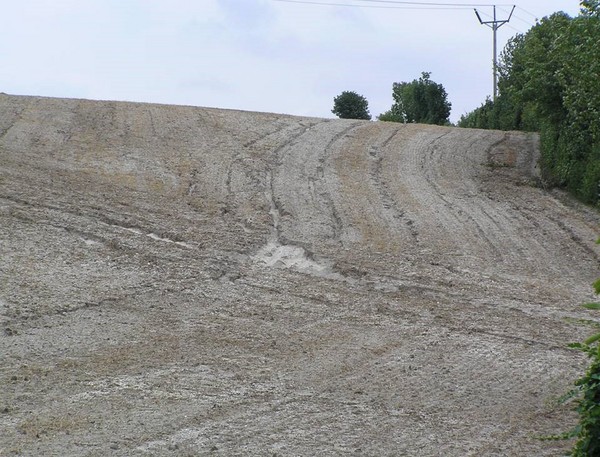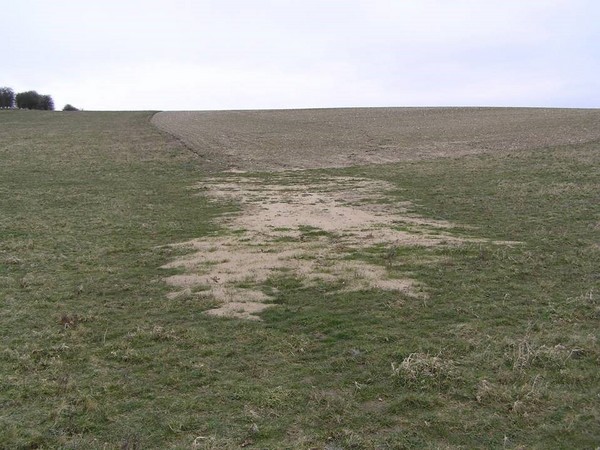'I was there' and witnessed Ben Stokes turning the third Ashes test match upside down.
In a blog a few years ago I said we were present on super-Saturday at the London Olympic Stadium and saw the Team GB win three athletics gold medals. It seems that a few people didn't believe me then and so I have taken the opportunity to print a copy of my ticket to Headingley. Now do you believe? It is always good to have sound evidence.

Talking of good evidence...
As a member of the board of the Voluntary Initiative (VI), I keep abreast of the scientific literature on the movement of pesticides to water. One particular interest is water run-off and the resulting soil erosion. This is an important issue, not only for maintaining productive soil in the field but also for keeping pesticides out of water. Pesticide residues can be both in the water run-off or attached to eroded soil particles.
It stands to reason that the steeper the slope the more water run-off and erosion. Hence, you can imagine my surprise when I read a recently published paper that concluded run-off was progressively less with an increasing slope of up to 20 degrees (a 1 in 2.92 slope or a 36.4% slope).
When one reads a scientific paper that blows your perceptions apart the natural tendency is to search for more information. When I did this, I found that some other papers concluded that the degree of slope may not be the dominating factor controlling water run-off and soil erosion. There are a host of scientific explanations for this. The really obvious one is the length of slope because the longer the slope the greater the area for water to be deposited by a rainfall event.
However, there are other less obvious factors, such as sealing of the soil surface (slaking), water infiltration rate in the presence and absence of surface sealing, and the different patterns of water flow across the soil surface on different degrees of slope. However, there are really no hard and fast rules and there are large variations in the results of studies on this subject. This is because the results can differ according to other factors such as soil type, soil condition, moisture status of the soil before an erosion event, and the amount and intensity of rain causing the water run-off and erosion event.
The situation is further complicated by the presence of tramlines. The studies quoted above were done in the absence of tramlines. I know from personal experience of local research projects that tramlines can account for around 80% of the run-off from combinable cropped fields. This is because their compacted surface layers, particularly when trafficked under wet soil conditions, provide a channel that usually runs downhill on sloping fields. There are two sources of water in tramlines. First, rain can fall directly onto them and second, water carrying sediment runs across the neighbouring soil surface and into them.
The latter is often the dominant source of both water and soil particles in significant run-off events. Therefore, many of the research conclusions regarding the importance of soil cover, soil aggregate stability and water infiltration rates are still relevant. However, I am not convinced that the particular conclusion on the absence of a relationship between degree of slope and run-off applies to tramlines.
Simple observations
With all the variability in the data, there are two simple observations. First, the industry has to change its perception of what is a significant slope in terms of the risk of water run-off and soil erosion. Second, we need to accept that other factors can be equally or even more important than slope in determining water run-off and soil erosion risk.
Many commentators have suggested that a slope above 3.6% degrees (a 1 in 20 or 5% slope) is the threshold for taking measures to reduce the threat. I think, based on scientific literature, that figure should be reduced to about 2 degrees (a 1 in 30 or 3.5% slope). Whilst this kind of slope may be considered a hill here in the City of Cambridge, it is barely perceptible in some other parts of the country.
This means that a higher proportion of arable land than I had previously thought is vulnerable to water run-off and soil erosion. However, the fact that other issues can be as important or even more important than slope increases the management options and hence our ability to reduce water run-off and erosion. Looking at the scientific literature with a practical eye, some are potentially more successful than others.
Naturally, the higher the water infiltration rate of the soil, the less surface ponding and hence less run-off will occur. Minimising the impedance of water moving into the soil profile is of prime importance not only to reduce run-off but also for healthy crops.

Increasing soil aggregate stability will reduce the impact of rain drops breaking up soil aggregates on the surface into their component parts; they, in turn, are more likely to be washed downhill. In addition, reducing or preventing soil surface sealing or slaking resulting from the breaking up of soil aggregates will help to maintain soil infiltration rates.
Increasing soil organic matter in the surface layers of the soil will increase soil aggregate stability. Even small increases can have a considerable effect. This may be why shallow tillage usually, but not always, reduces soil erosion because of the higher levels of organic matter in the soil surface layers. This reduction in soil erosion can occur despite run-off often being higher with shallow tillage. This is because ‘tighter’ soil surface layers can result from the adoption of this approach to primary tillage.
The impact that shallow tillage has on pesticide movement in water run-off and on eroded soil is a matter of conjecture. It takes two or three days for pesticides to adsorb onto soil particles. Theoretically, this may mean that any increase in water run-off will contain more pesticide if it results from rain during the first few days after spraying as opposed to run-off that occurs from rain falling following a few dry days immediately after spraying. Experience shows that the adoption of direct drilling or shallow tillage certainly does not mean that serious peaks of pesticides in raw water can be avoided.
Soil cover by plants or crop residues is very effective in preventing the direct impact of rain drops shattering soil aggregates. Recent studies suggest that very significant reductions in run-off and erosion start to occur when at least 40% of the soil surface is covered. Plant cover has the advantage over crop residues because the roots may facilitate increased infiltration rates. In addition, plants pump water out of the soil. Hence, the current interest in cover crops and companion crops for the late autumn/early winter can only be positive for reducing run-off and soil erosion.
Tramline placement and management remain a priority. It is important that tramlines do not provide a direct route for water and soil to leave fields. Therefore, entering the field on the top of a slope, rather than the bottom, can have a huge impact on reducing run-off and soil particles leaving the field. Please note, watercourses tend to be at the bottom of slopes! Tramline management is also critically important.
Ensuring that there is a crop or plants sown in the tramline is one approach to reducing water and soil particle run-off. There are field studies which demonstrate that cultivating or ridging the tramlines can be very successful.

Cultivating, sowing and laying out tramlines along contour lines is promoted by some. However, it is very difficult to achieve in practice and can lead to higher levels of run-off and soil erosion where there are dry valleys across the main slope. This is because these provide the opportunity for several tramlines established across the main slope to deliver water into a relatively small area of land with obvious consequences; hence, this strategy is not generally successful.
Any soil loss due to water or wind erosion is regrettable and mitigation comes a poor second to prevention. Buffer strips can protect watercourses from water run-off and eroded soil particles which may carry pesticides. Simple prescriptions of widths and locations for these can be very unsatisfactory.
It is really necessary to go out during or shortly after heavy rain, say after at least 10 mm has fallen, to see where buffer strips should be located and/or how effective are the existing ones. They will have to be wider than six metres in many cases, particularly for run-off and erosion from dry valleys running across a slope. In many parts of the world, dry valleys are sown with permanent grass to reduce the amount of run-off and soil particles reaching water courses.
In conclusion
Recently published scientific literature has opened up additional options to reduce further water run-off and erosion. We have to apply that information. Recognising that even the gentlest slope can present a problem is a very important step together with the adoption of measures to increase the infiltration rate of water and soil aggregate stability, including soil cover by plants and/or crop residues.
There is also a long way to go on getting the placement and width of buffer strips right but we have made a useful start …. AND please think about tramline placement and management. Walking the farm during or shortly after significant rainfall events (I know, I know!) to witness what is actually happening is a really worthwhile task.
The invaluable advice received from Professor John Quinton of the Lancaster Environment Centre of Lancaster University is gratefully acknowledged.
